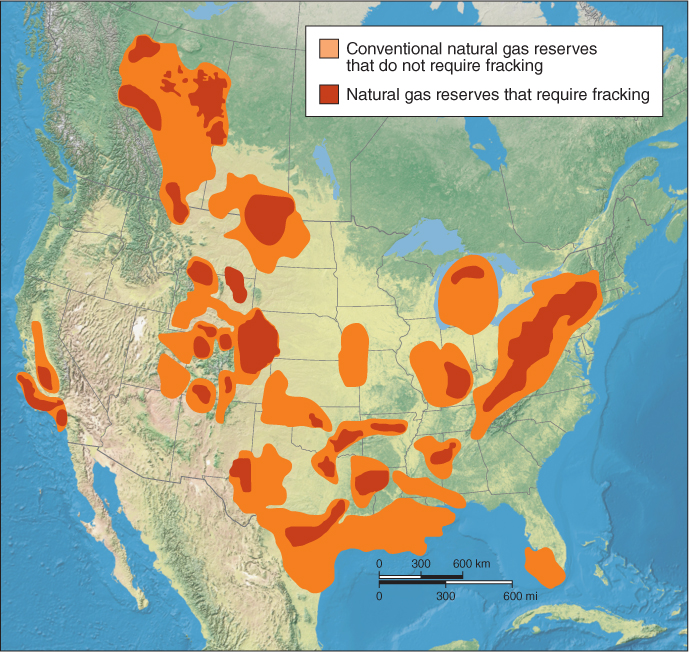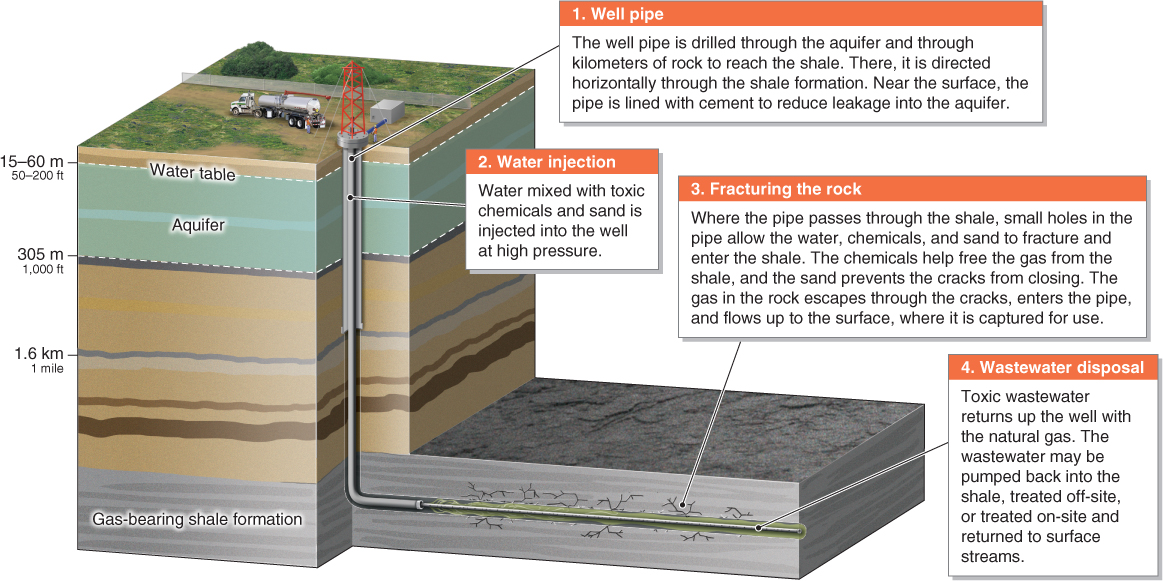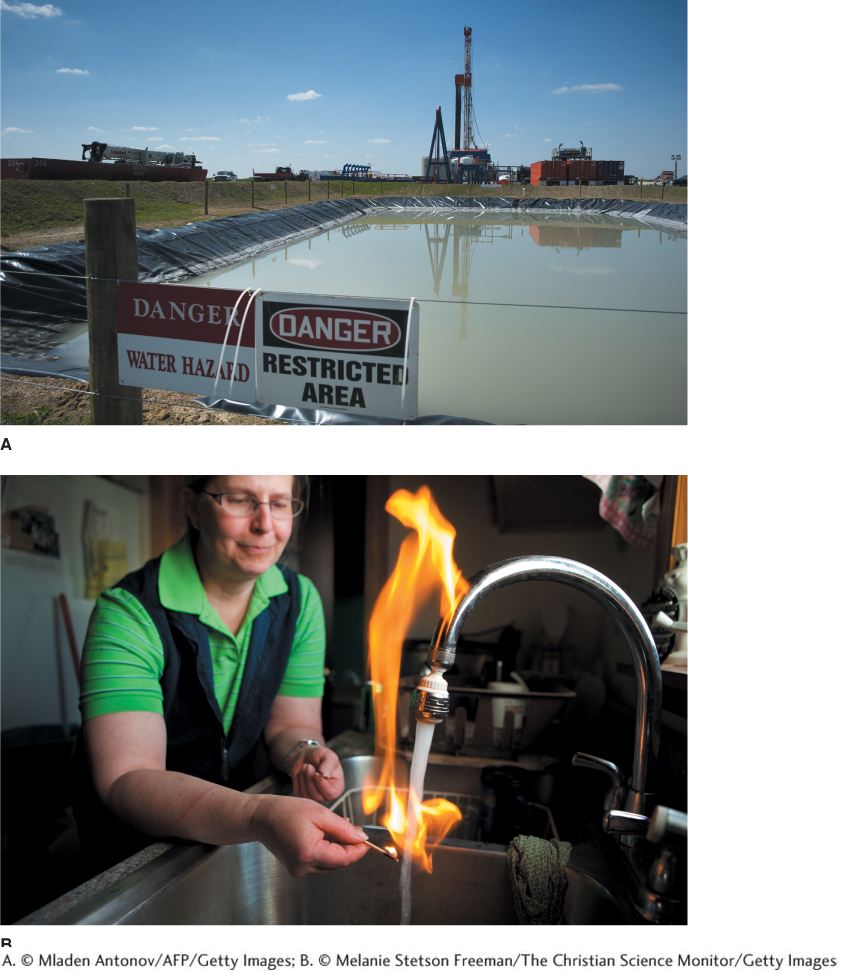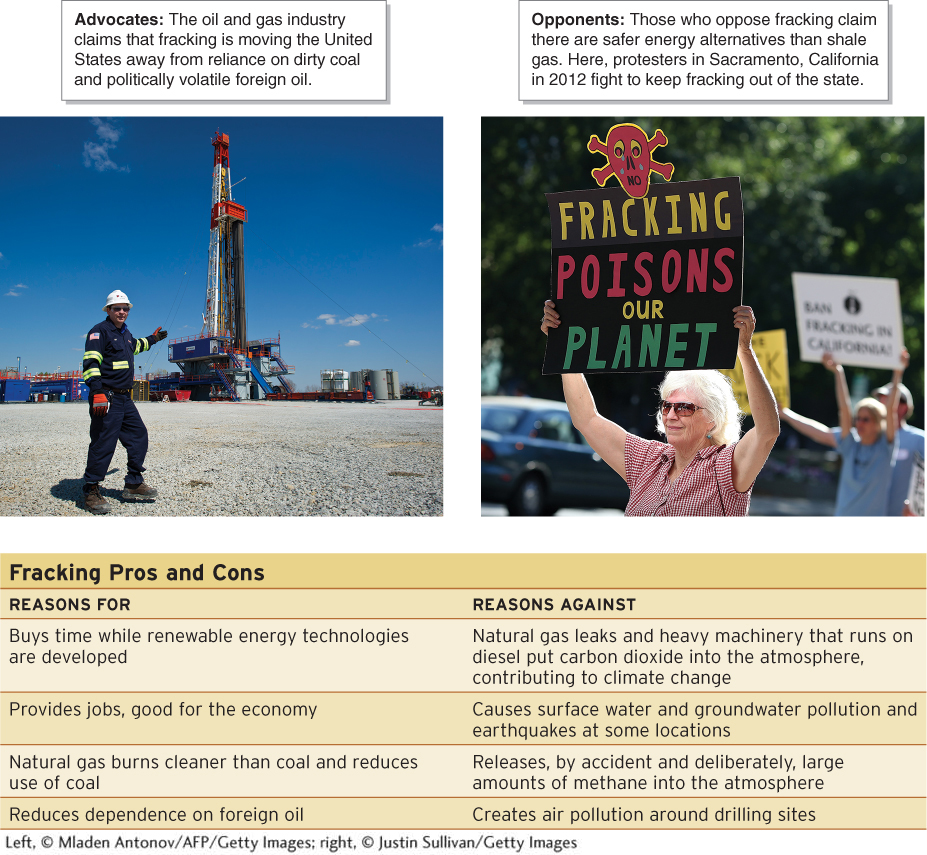13.5 Fracking for Shale Gas

Assess the pros and cons of extracting natural gas trapped in shale through hydraulic fracturing.
Fracking is short for hydraulic fracturing: a procedure in which water, sand, and chemicals are pumped under high pressure into shale bedrock to extract natural gas and oil trapped in the pores of the shale. This technique was first developed in the 1940s and has become common practice in many regions worldwide in the last decade.
fracking
(or hydraulic fracturing) The procedure by which water is pumped under high pressure into a shale formation to extract natural gas and oil.
As the prices of fossil fuels rise, it becomes economically profitable to develop reserves that are more difficult and more expensive to use, such as shale gas. In the United States, the number of oil and gas wells almost doubled between 1990 and 2009 to 493,000. As of 2012, there were 483,000 wells producing natural gas in the United States (Figure 13.18).

Figure 13.18
Fracking is projected to take on an increasingly significant role in meeting U.S. energy needs in the coming decades. In 2000, shale gas provided only 1% of natural gas supplies in the United States. By 2035, it is estimated that half of U.S. gas production will be made available through fracking. Natural gas provides about 30% of the energy consumed in the United States, but this number is rapidly growing because of fracking.
There are about 187 trillion m3 (6.6 quadrillion ft3) of natural gas locked in shale worldwide. China, Argentina, the United States, and Mexico have the largest shale gas reserves in the world. Figure 13.19 shows where gas-

Figure 13.19
How Fracking Works
Shale, as we saw in Section 13.3, is a fine-
To speed up the flow of gas from a well drilled in shale, water, sand, and a cocktail of nontoxic and toxic chemicals are injected at high pressures into the well to fracture the rock. Fracturing increases the permeability of the rock and lets oil and gas escape up the wellhead, where it can be captured and used. Figure 13.20 diagrams the process of fracking.

Figure 13.20
435
This procedure sounds straightforward: We get more natural gas from shale by injecting water, sand, and chemicals into it. Several potentially serious problems result from this method of gas extraction, including water pollution.
Question 13.8
What is fracking and why is it controversial?
Fracking is a method used to extract natural gas from shale. Proponents argue that it produces clean energy, while opponents argue that it pollutes water and air.
Fracking Fluid
Each fracking operation at each well requires about 26 million L (7 million gal) of water. Millions of liters of toxic and radioactive wastewater, called fracking fluid, are left over after a fracking operation is complete. This wastewater is collected at the fracking site and must be safely disposed of.
Why is the water toxic and radioactive? Chemicals such as benzene and xylene, two known carcinogens, are sometimes added to water during the fracking process to help bring out the gas. In addition, the water absorbs natural radium from the rock, becoming radioactive in the process.
The fracking industry has been grappling with how to dispose of the millions of gallons of toxic fracking fluid it produces. Fracking fluid has been discharged into rivers and sent to wastewater treatment plants, neither of which can handle its volume and contaminants. So far, the best solution seems to be to inject it back underground under high pressure. Unfortunately, injecting fracking fluid back in the ground can trigger earthquakes. A study published in Science in July 2014 definitively linked disposing of fracking fluid in this way to increased earthquake activity in central Oklahoma. An even bigger problem, injecting fracking fluid back into the ground may contaminate groundwater supplies.
436
Drinking Water
Opponents of fracking claim that it contaminates drinking water supplies in two ways. First, the toxic fracking fluid finds its way to surface streams and drinking water supplies through accidental trucking spills or leaks from pipelines and containment ponds (Figure 13.21A). Opponents also argue that fracking threatens drinking water supplies with methane gas contamination (Figure 13.21B). Methane has contaminated drinking water in Colorado, Ohio, New York, Pennsylvania, Texas, and West Virginia. Samples from 60 water wells near fracking operations in northeastern Pennsylvania and upstate New York found methane concentrations 17 times higher than average in drinking water supplies. Where it occurs, methane contamination of water by fracking is most likely to be caused by failure of the cement casing placed around the well where it passes through groundwater (see Figure 13.20).

Figure 13.21
Air Pollution and Climate Change
Natural gas burns cleaner than coal, and it has been hailed by many environmentalists and the natural gas industry as a clean alternative to coal. A report published in Nature in 2013 challenged this view. The report found that up to 9% of the natural gas being extracted from fracking wells in Utah leaks directly into the atmosphere. Compared with carbon dioxide, molecule for molecule, methane is 21 times more potent as a greenhouse gas. If the Utah wells are representative of the industry as a whole (which is not yet known), then natural gas obtained through fracking is a more carbon-
Summing Up: The Pros and Cons
In some areas, the perceived risks of fracking outweigh its perceived benefits. Many U.S. states, counties, and cities have issued moratoriums on fracking or are considering legislation that would restrict fracking. For example, New Jersey, North Carolina, and New York, as well as the cities of Buffalo (New York) and Pittsburgh (Pennsylvania), have issued moratoriums on fracking within their jurisdictions. In 2012, Vermont banned all fracking. The Canadian province of Québec suspended fracking in 2012, and France banned fracking in 2011.
437
These jurisdictions are exceptions. Fracking proceeds apace in most of the United States and around the world. Some governments, such as South Africa’s, have even lifted bans on fracking and are forging ahead with it. The pros and cons of fracking for the United States are summarized in Figure 13.22.

Figure 13.22
People need energy. From the standpoint of climate change, natural gas is a preferable option to relatively dirty coal. Unfortunately, all fossil fuels, natural gas included, contribute to climate change. Looking ahead several decades, it remains to be seen whether the current boom in natural gas development will provide a relatively clean source of energy while renewable energy sources are developed or whether it simply is a continuation of society’s dependence on fossil fuels.
438